Deltek Releases New Support Center
Deltek rolled out its new customer support center on Monday, October 9th, 2017. The support center has been improved allowing users to learn, connect and more effectively manage their experiences. Entering the Deltek Support Center after October 9th, you now see a message that looks like this:
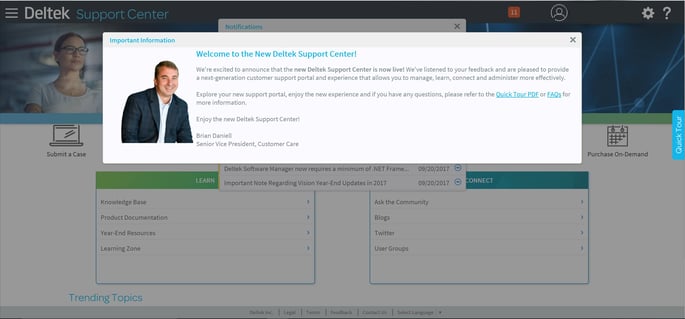 Deltek Support Center Welcome Screen
Deltek Support Center Welcome Screen
New Login Feature
There is a new login feature when using the enhanced support center. You will still navigate to the same URL that you previously used. Prior to the new help center, you would have seen a login button and an account assistance button. However, you will notice that, where the account assistance button used to be, it now says “Need Help?”
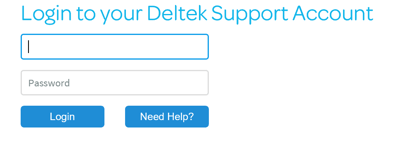
Deltek Support Center Login Screen
When you click on “Need Help?,” you now have the option to chat with someone. This feature offers the real-time ability to speak with a Deltek professional who can assist you. To access the chat, you will need to enter your email address and then click “Start a Chat.”
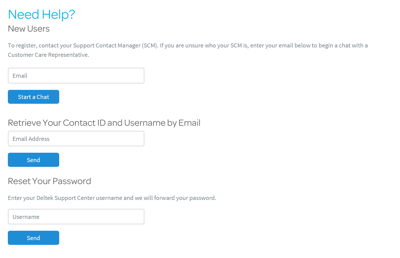
Deltek Support Center Login Assistance Screen
To get back to the login page from this page, you will need to click the silhouette ![]() in the top right corner. This will enable you to log into the support center.
in the top right corner. This will enable you to log into the support center.
Stay Up to Date with Notifications
After logging in, you will receive the critical info pop-up announcing the new site. When you close this pop-up, or if you are logging in after the alert has been removed, you will immediately be presented with a list of notifications.
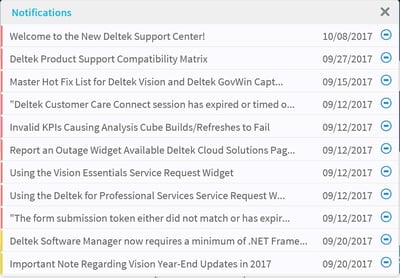
Deltek Support Center Notifications Popup
Key highlights of the notifications popup include:
- The notifications are equivalent to the old alerts and announcements section
- You can hide the notifications popup if you do not wish for it to popup every time you open the support center
- Global notifications are color coded: high (red), med (yellow) and low (green)
- You will only see alerts for the products that you own
- You can click on the number in the orange square at the top of the screen which indicates how many notifications there are if you choose to hide the notifications
Manage Your Deltek Support Center Account
In the upper right, you will see the gear icon. This icon allows you to open the “My Account” section. This is where you update your profile settings, and you can also see the current support plan you have.
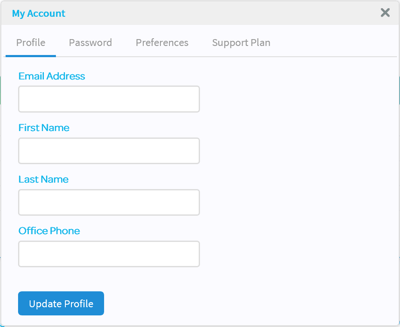
Deltek Support Center Account Management Screen
The account management section allows you to change the following:
- Password
- Preferred language
- If you want or do not want to see notifications
Get Support for Your Deltek Products
The search bar offers you the ability to look for forums, posts and knowledge based articles using specific words or phrases. Everyone will see the learn and connect information boxes, and if you are an administrator, there will be an additional box that will be available. Below the information boxes are “Trending Topics,” which show the top ten articles for the products that you own for the last thirty days. You will only see the topics in this list that relate to the products that you own.
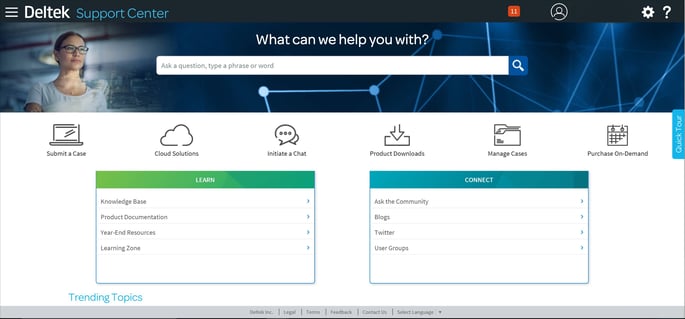 Deltek Support Center Main Page
Deltek Support Center Main Page
Depending on the level of support you have, you will possibly see up to six icons. The icons you view are driven by permissions. If you can’t find the answer, submit a case. Deltek will then research your inquiry. Availability, however, depends on the type of service plan you have purchased. Here are the options you will see depending on your license agreements:
- Cloud Solutions- You will see this is if you own a Saas product. When clicking this icon, you will be able to choose the cloud solution you are needing help with. This will open a wide range of help topics specific to your needs.
- Initiate a Chat- This icon allows you to enter a chat with Deltek staff. Be sure to check the bottom of the chat page for specific hours of availability.
- Product Downloads- The Deltek Software Manager (DSM) is your central place to download all the Deltek products you own, including all service packs and hot fixes.
- Manage Cases- Here you can check the status, view details, and update your support cases. Previously called, “My Support Cases.”
- Purchase On-Demand - Deltek's “On-Demand Support” is available for situations that require brief, one-time access to our support experts for situations that are not covered by your annual maintenance fee.
If you have less than three icons available, they will not show. You can still access the available options by going to the upper left-hand corner of the screen and utilizing the menu to navigate to your desired destination.
Enjoy the New Deltek Support Center
As you can see, the new customer service center is not only user friendly, but it eliminates information that does not pertain to you. The updated service center’s ultimate goal is to help you continue to get the most out of your Deltek product. Click here for more information about the Deltek Support Center.



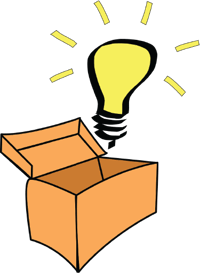 At a recent client meeting, it was brought to light how many of my clients don’t use Deltek Vision’s approval engine capabilities. I thought how crazy that notion was because using the approval engine can save clients so much paper and time. Let me share with you what this firm experienced in dealing with approvals, and let’s see how many of you can think outside the box and see the benefits of Deltek Vision’s approval engine.
At a recent client meeting, it was brought to light how many of my clients don’t use Deltek Vision’s approval engine capabilities. I thought how crazy that notion was because using the approval engine can save clients so much paper and time. Let me share with you what this firm experienced in dealing with approvals, and let’s see how many of you can think outside the box and see the benefits of Deltek Vision’s approval engine.
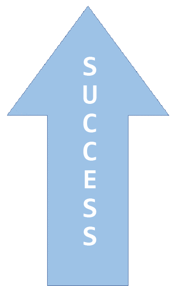 Charles Darwin once said, “it is not the strongest of the species that survives, nor the most intelligent, but the one most responsive to change.” In the 21st century, with constantly evolving technology and ever present social media, competition for the same resources has dramatically increased. Firms must adapt to their new environments or risk extinction. Change management, the approach used to prepare, equip and support individuals to successfully adopt change and thus drive organizational success, is vital to a firm’s continued existence.
Charles Darwin once said, “it is not the strongest of the species that survives, nor the most intelligent, but the one most responsive to change.” In the 21st century, with constantly evolving technology and ever present social media, competition for the same resources has dramatically increased. Firms must adapt to their new environments or risk extinction. Change management, the approach used to prepare, equip and support individuals to successfully adopt change and thus drive organizational success, is vital to a firm’s continued existence.
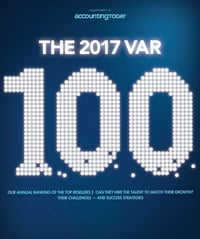 Full Sail Partners, a Deltek Platinum Partner, is proud to announce that it has been recognized by Accounting Today on the top 100 VAR list for 2017. Accounting Today annually chooses the top value-added resellers (VARs), and Full Sail Partners has been ranked in the top 100 again this year. Not only was Full Sail Partners named on the 2017 list, but it impressively moved up in ranking by fifteen.
Full Sail Partners, a Deltek Platinum Partner, is proud to announce that it has been recognized by Accounting Today on the top 100 VAR list for 2017. Accounting Today annually chooses the top value-added resellers (VARs), and Full Sail Partners has been ranked in the top 100 again this year. Not only was Full Sail Partners named on the 2017 list, but it impressively moved up in ranking by fifteen.  The long-term success of a sports team cannot be determined by looking at just one factor. For a sports team to truly excel, it must triumph on many fronts. From scouting the best talent to strategizing offensive and defensive plays for cohesive team execution, the team manager must create a winning formula that, when utilized, brings continuous success for the team. This is also true for professional services firms, and finding the right formula for your team can become less of a guessing game with the tools available from Deltek. Let’s see how Deltek can help your firm knock it out of the park.
The long-term success of a sports team cannot be determined by looking at just one factor. For a sports team to truly excel, it must triumph on many fronts. From scouting the best talent to strategizing offensive and defensive plays for cohesive team execution, the team manager must create a winning formula that, when utilized, brings continuous success for the team. This is also true for professional services firms, and finding the right formula for your team can become less of a guessing game with the tools available from Deltek. Let’s see how Deltek can help your firm knock it out of the park.
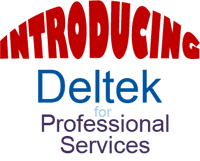 Welcome to Deltek for Professional Services (DPS), the next generation solution for professional services automation (PSA). If PSA is a new term for you, think of it as a specialized system like an enterprise resource planning (ERP) solution except specifically designed for the professional services industry. Also, check out this short article to
Welcome to Deltek for Professional Services (DPS), the next generation solution for professional services automation (PSA). If PSA is a new term for you, think of it as a specialized system like an enterprise resource planning (ERP) solution except specifically designed for the professional services industry. Also, check out this short article to 

 Full Sail Partners, a Deltek Platinum Partner and Client Feedback Tool Premier Partner, is pleased to announce the addition of Lindsay Diven, CPSM to the consulting services team. Lindsay has joined the firm as a senior Deltek Vision CRM consultant. In this position, she will work with clients to implement Deltek Vision’s CRM, Custom Proposal, and SF330 modules, as well as the Client Feedback Tool.
Full Sail Partners, a Deltek Platinum Partner and Client Feedback Tool Premier Partner, is pleased to announce the addition of Lindsay Diven, CPSM to the consulting services team. Lindsay has joined the firm as a senior Deltek Vision CRM consultant. In this position, she will work with clients to implement Deltek Vision’s CRM, Custom Proposal, and SF330 modules, as well as the Client Feedback Tool.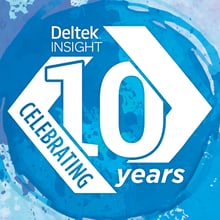 Deltek Insight 2017 is fast approaching! Have you made your plans to go? This year it will be in Nashville, Tennessee from October 23rd to 26th at the Gaylord Opryland Resort. If you aren’t yet convinced of why you should attend Deltek Insight, here’s a look at some reasons to make it worth your while.
Deltek Insight 2017 is fast approaching! Have you made your plans to go? This year it will be in Nashville, Tennessee from October 23rd to 26th at the Gaylord Opryland Resort. If you aren’t yet convinced of why you should attend Deltek Insight, here’s a look at some reasons to make it worth your while.
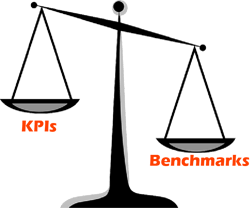 How does your company measure up to the competition? Are you performing above the industry standards or below? Are you achieving the objectives necessary to continue to grow and operate successfully? In order to answer these questions, management must have a way to track performance. Evaluating the progress of individuals, projects, and specific departments is important, but management also needs an in depth look at the company as a whole.
How does your company measure up to the competition? Are you performing above the industry standards or below? Are you achieving the objectives necessary to continue to grow and operate successfully? In order to answer these questions, management must have a way to track performance. Evaluating the progress of individuals, projects, and specific departments is important, but management also needs an in depth look at the company as a whole.